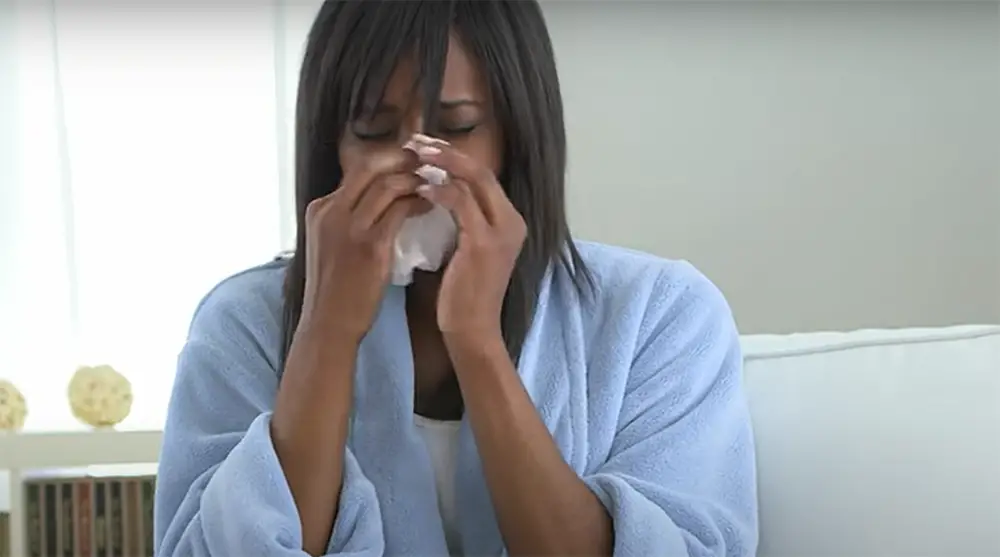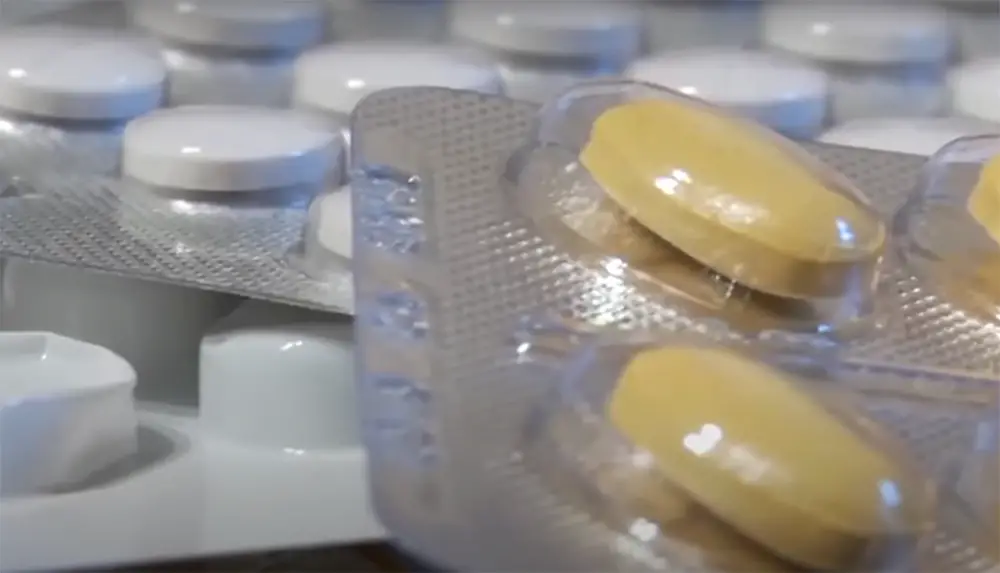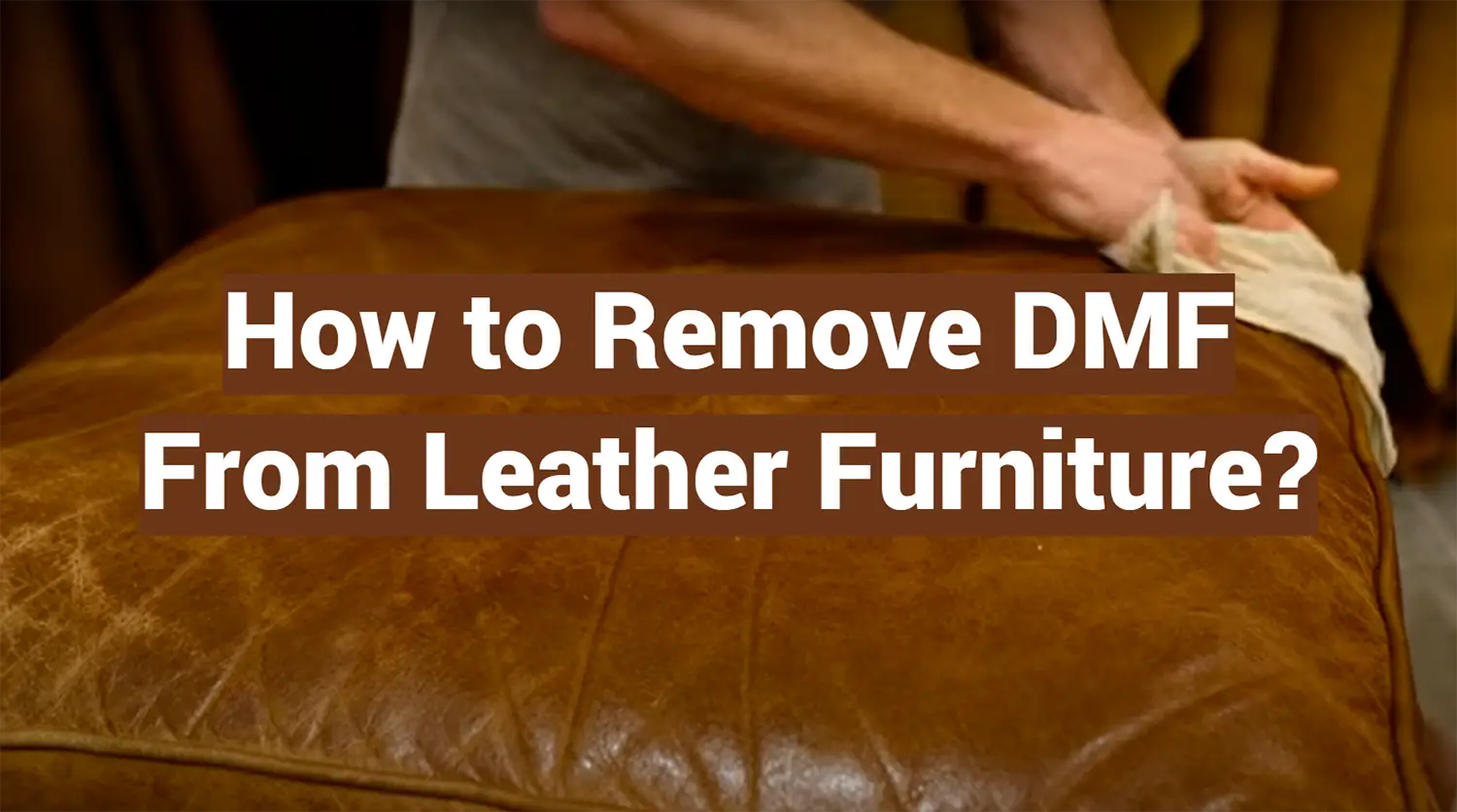Do you have leather furniture that has been stained with DMF? Don’t worry, we can help! In this comprehensive guide, we will discuss everything you need to know about how to remove DMF from leather furniture. We will cover the causes of DMF staining, what you can do about it, and how to prevent the allergy from happening in the future. So don’t despair – read on for all the information you need to get your leather furniture looking as good as new!
What is a Dimethyl Fumarate?
A Dimethyl Fumarate (DMF) is a white, odorless, crystalline powder that is used in a variety of industries as a preservative and fungicide. It can be found in products such as adhesives, textiles, plastics, and leather. DMF is also used as a fumigant for molds and mildew.

The other names for DMF are:
- Methyl fumarate
- Dimethyl ester
- Allomaleic acid dimethyl ester
Why is DMF Used with Furniture
DMF is used as a preservative in many industries, but it is most commonly found in the leather industry. It is used to preserve and protect leather from mold, mildew, and other fungi. DMF is also used as a fire retardant.
Tiny bags of DMF are placed inside upholstered furniture and other products to help prevent the growth of mold and mildew. As the time passes however, the DMF can permeate into the leather. [1], [2], [3], [4]
Controversies Surrounding the Use of DMF
There has been some controversy surrounding the use of DMF in furniture. Some people are concerned about the potential health effects of exposure to DMF.
While DMF is considered by many to be a safe and effective way to treat leather furniture, there are some who believe that it can be harmful. Some people have reported skin irritation and burning sensations after coming into contact with DMF-treated furniture. There have also been reports of respiratory problems and headaches in people who have been exposed to high levels of DMF fumes.
The European Union has banned the use of DMF in furniture due to these concerns. However, the United States has not followed suit and currently allows the use of DMF in furniture manufacture. [1], [2], [3], [4]
Signs of DMF Allergy
DMF allergy is also known as coach dermatitis. Symptoms of coach dermatitis include redness, itching, and burning of the skin. In severe cases, the skin may blister or ulcerate.
Exposure to DMF can occur through inhalation, ingestion, or absorption through the skin. Prolonged exposure is necessary for the development of symptoms.

You can also get diagnosed by a professional. Make an appointment for a path test to see if you have an allergy. Path test is a skin or blood test that can determine whether you are indeed allergic to DMF. [2], [3], [7]
How to Remove DMF From Your Leather Furniture
If you’re concerned about the potential health effects of DMF, you may want to consider removing it from your leather furniture. Unfortunately there’s not much you can do about it.
Cover it with allergen barrier covers
The easiest way to protect yourself from exposure to DMF is to cover your furniture with allergen barrier covers. These covers will create a barrier between you and the furniture, preventing contact with the DMF.
To use anti-allergen covers, simply place them over your furniture. The covers have an elastic edge that will keep them in place. You can purchase them online or at most major retailers. [5], [6]
Change your furniture to be 100% safe
However, the recommended way to remove DMF from your house is to change your furniture to be 100% safe. From now on, you should look for furniture that is made without DMF before purchasing a new one. You can also check for companies that avoid the use of the chemical altogether. [7]
How to Prevent Sofa Dermatitis
Leather furniture containing DMF is a common source of dermatitis flare-ups. The condition, also known as hide or leather contact dermatitis, can cause intense itching, redness, and scaling. If you’re one of the unlucky few who suffer from this affliction, you’re probably wondering how to prevent sofa dermatitis.
The best way to prevent this is to avoid touching and using items that use the chemical. If you must touch or use such items, wear gloves and wash your hands afterwards. If you bought a pair of shoes containing a DMF satched, you need to let them air for weeks or even months.
If you think your furniture may contain DMF, there is unfortunately no way to do this after you make a purchase and start to develop an allergy. When shopping, you can check for the labels like ‘anti-mold’ or ‘silica gel’ as not all companies point out the presence of DMF in their products.
Once you have determined that your furniture does indeed contain DMF, you’ll unfortunately have to get rid of it. [2], [3]
How to Treat the DMF Allergy
If you have a DMF allergy, it’s important to take steps to treat the condition.
Remove the source of exposure
The first step is to remove the source of exposure. If you’re allergic to DMF, you’ll need to avoid contact with the substance. This means avoiding products that contain DMF, such as furniture polish or cleaning products. You may also need to avoid certain types of leather furniture or shoes as the chemical can penetrate the leather even through the sachet.

If you have a severe allergy, you may need to take additional steps, such as wearing gloves or a mask when you’re around potential sources of exposure.
Treat the inflammation
If you have a DMF allergy, you may also experience inflammation. This can be treated with over-the-counter emollients or prescription medications.
Undergo systemic steroid therapy in severe cases
Severe allergies to DMF can sometimes be treated with systemic steroid therapy. This type of treatment is usually only necessary if you experience a severe reaction, such as anaphylaxis.
Systemic steroid therapy can have side effects, so it’s important to discuss the risks and benefits with your doctor before starting treatment.
Keep in mind that every case is different. The best way to treat a DMF allergy is to work with your doctor to develop a plan that’s right for you. [3], [7]
FAQ
What is DMF in leather?
DMF is a chemical that is often used in the manufacturing of leather furniture. This chemical helps to protect the leather from mold and mildew, and it also makes the leather more pliable.
While DMF is considered safe for use in leather furniture, some people may be sensitive to it. Symptoms of exposure to DMF include skin irritation, watery eyes, and difficulty breathing. If you experience any of these symptoms after coming into contact with leather furniture that contains DMF, you should seek medical attention immediately.
How do I remove allergens from my couch?
To remove allergens from your couch, you may use specialized allergen reduction products. You should also vacuum your couch regularly using a HEPA filter to prevent the build-up of allergens.
If that doesn’t help, you can upholster your couch in allergen-resistant fabrics. This can also make your furniture easier to clean.
Finally, consider using an air purifier in your home to filter out allergens from the air.
Why does my leather couch make me itch?
One possible reason your leather couch is making you itch is that it contains dimethyl fumarate (DMF). DMF is a common preservative used in leather furniture, but it can be a skin irritant for some people. If you think your couch may contain DMF and you experience allergic reactions from it then you should replace it altogether.
How do I know if my couch has DMF?
If you’re not sure whether or not your couch has DMF, there are a few things you can look for. First, check for a label or tag that says “DMF-free.” If you don’t see one of those, look for a peeling or cracking finish, which may be a sign that the couch has been treated with DMF. Finally, try to find out if the company that made your couch uses DMF in their leather finishing process.
If you live in Europe, it’s also worth noting that the European Union has banned the use of DMF in leather products. So, if your couch was made in Europe, it’s likely that it doesn’t have DMF. In the US, however, the use of DMF in leather products is not currently regulated.
How do you degrease a leather couch?
DMF (dichloromethane) is a chemical solvent that is commonly used in furniture manufacture. It is a very effective degreaser, but it is also very harmful to human health. That is why it is being phased out in many countries.
If your furniture has been treated with DMF, the best way to remove it is by using a commercial product called “UnDoo”. This is an organic solvent that dissolves DMF and other solvents from leather and vinyl. It can be purchased online or from some hardware stores.
Be sure to follow the safety instructions on the UnDoo container, and always wear gloves and protective eyewear when using this product.
Can you use vinegar on a leather couch?
50/50 vinegar and water should be safe to use on a leather couch. You can also use a leather conditioner if you want to be extra cautious.
Vinegar is a natural cleaner and disinfectant that can be used to clean surfaces in your home, like leather furniture. It’s important to note that vinegar is a mild acid and can therefore cause damage if it’s not diluted properly.
It’s always a good idea to do a spot test before using any cleaning product on an expensive piece of furniture. This way, you can make sure that the product doesn’t damage the furniture.
What is the best homemade leather cleaner?
The best homemade leather cleaner is a 50/50 mixture of oil and vinegar. Apply the cleaner to a soft cloth, and rub it into the leather in a circular motion. Let the leather dry completely before applying any kind of conditioner.
Leather needs to be regularly cleaned in order to remove dirt, dust, and other debris that can damage it over time. Clean your leather furniture with natural cleaners like oil and vinegar.
These cleaners will help remove dirt and grime while also keeping the leather looking new and shiny.
Is olive oil good for leather?
Yes. Olive oil is a natural product that can be used to clean and protect leather. It not only restores the color of faded leather, but also helps to repair small scratches.
To clean and protect leather using olive oil, apply a small amount of oil to a cloth. Rub the oil into the affected areas. Let the oil soak in for a few minutes. Buff it off with a dry cloth. Repeat as necessary.
Is baby oil good for leather?
No, baby oil is not good for leather. In fact, it can actually be quite harmful. Baby oil is a mineral oil, meaning that it is made up of long-chain hydrocarbons. These hydrocarbons are nonpolar and therefore they do not mix with water.
This means that when baby oil is applied to leather, the hydrocarbons will sit on top of the leather and will not be absorbed. This can lead to the leather becoming dry and brittle over time.
Is it safe to use a blow dryer to remove the DMF from leather furniture?
It is not safe to use a blow dryer to remove the DMF from leather furniture. The heat from the blow dryer can actually cause the DMF to vaporize, and you could potentially breathe in the vaporized DMF.
It’s a good idea to consult with a professional furniture cleaner if you want to remove the DMF from your leather furniture.
Is it possible to remove the DMF from leather furniture without damaging it?
Yes, it is possible. First, identify the type of leather on your furniture. There are three types of leather that are commonly used in furniture: aniline, pigmented, and simulated aniline. Aniline is the most delicate and vulnerable to damage, while pigmented leathers are the most durable.
Once you have identified the type of leather on your furniture, find a cleaning product that is specifically designed for that type of leather. If you can’t find a specific cleaning product, you can use a general purpose cleaner such as vinegar or Murphy’s Oil Soap, but be sure to test it in an inconspicuous area first to make sure it won’t damage the leather.
Apply the cleaner to a soft cloth and rub it into the leather in a circular motion. Be sure to work the cleaner into all of the nooks and crannies. Rinse the area with clean water and dry it with a clean towel. Repeat as necessary.
How can I prevent the DMF from coming back to my leather furniture?
There are a few things you can do to help prevent the DMF from coming back and staining your leather furniture. There are a few things you can do to keep your furniture looking nice.
First, don’t let it get too much direct sunlight, because the UV light will make the dye fade over time. Second, try not to eat or drink anything near your furniture.
And finally, once a week, use a soft cloth to put a thin layer of leather conditioner on the surface of your furniture. This will help protect it from moisture and dirt, and will also help keep it looking new for years to come.
Useful Video: How-To Use Leather Degreaser
Conclusion
If you suffer from an allergy to DMF, it’s best to avoid leather furniture and shoe boxes altogether. Unfortunately, this can be a challenge because DMF is found in so many everyday items. If you must come into contact with these products, make sure to take all necessary precautions and consult your doctor if you have any questions or concerns.
However, there are a few things you can do if your leather couch or chair has been affected by the chemical. You could cover your furniture with an anti-allergen cover, or remove the piece of furniture entirely and try to find a new piece of furniture that doesn’t contain DMF. Whichever route you decide to take, we hope this article has been helpful in informing you about the dangers of DMF and how best to protect yourself from its effects.
References:
- https://airmidhealthgroup.com/dimethyl-fumurate-in-furniture-and-footwear.html
- https://www.news-medical.net/health/Treatment-and-Prevention-of-Dimethyl-Fumarate-Allergy.aspx
- https://dermnetnz.org/topics/allergy-to-dimethyl-fumarate
- https://www.leathermag.com/features/featuredimethyl-fumarate-dmf-product-ban-and-recall/
- https://couchdisposalplus.com/how-to-remove-couch-allergens/
- https://www.thespruce.com/create-allergy-free-home-right-furnishings-1391566
- https://krostrade.com/blog/how-to-remove-dimethyl-fumarate-from-sofa/







Leather furniture is a popular choice for many homes because it is classy and durable. However, leather furniture can also be difficult to maintain. One of the biggest challenges with leather furniture is removing DMF (dihydromyrcenol) stains. DMF is a common ingredient in many household cleaners and can leave a yellowish residue on leather furniture.
I have found that the best way to remove DMF stains from leather furniture is to use a mixture of white vinegar and water. First, blot the stain with a clean cloth dipped in the vinegar mixture. Then, rub the stain with a soft brush. Finally, rinse the area with cold water and blot dry with a clean cloth.
I have found this method to be very effective in removing DMF stains from my leather furniture. However, every piece of leather furniture is different, so it is important to test this method on an inconspicuous area before using it on the entire stain.